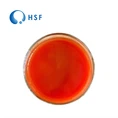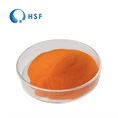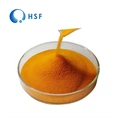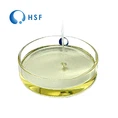The Definition of Vanillin
Vanillin, also known as methyl vanillin, is a well-known aromatic compound that adds a unique flavour to foods and beverages. It is most commonly found in vanilla beans, but can also be produced artificially for use in a variety of applications.
The origins of vanillin can be traced back to the Totonac people of Mexico, who were known for their cultivation of the vanilla orchid. The use of vanilla beans as a flavouring agent spread throughout the world during the 16th century, with Europeans bringing vanilla back to their home countries and incorporating it into their cooking.

The Process of Vanillin
The process of making vanillin powder involves several steps, including the production of raw materials, chemical synthesis, and purification.
The first step in making vanillin powder is the production of raw materials. Vanillin can be found in several natural sources, such as vanilla pods, cloves, and balsam of Peru. However, due to the high demand for vanillin in the food industry, most of the vanillin used today is synthesized in a laboratory using petrochemicals such as lignin.
The next step is chemical synthesis, where lignin is transformed into vanillin. The chemical synthesis process begins with the isolation of coniferyl alcohol from lignin. Coniferyl alcohol is the building block of vanillin and can be easily converted into vanillin through a series of chemical reactions. The most common method used for synthesizing vanillin is through the oxidation of coniferyl alcohol using chemical reagents such as potassium permanganate and nitric acid.
Finally, the vanillin that is produced needs to be purified to remove any impurities that may be present. The purification process involves several steps, including solvent extraction, distillation, and crystallization. The vanillin is first extracted from the reaction mixture using solvents such as methanol or ethyl acetate. The resulting mixture is then distilled to remove any remaining solvents and impurities. The final step involves crystallization, where the purified vanillin is cooled and allowed to crystallize.

The production process of vanillin powder involves many complex steps, including the production of raw materials, chemical synthesis, and purification. Although vanillin can be found naturally in some sources, most of the vanillin used today is synthetically produced due to the high demand in the food industry.
Application of Vanillin Powder
Vanillin powder, also known as vanilla powder, is a powdered version of the popular vanilla flavoring agent known as vanillin. This powder is a versatile ingredient that is commonly used in cooking, baking, and food preparation. Here are some of the most common applications of vanillin powder:
- Baking: Vanillin powder is often used in baking as a flavoring agent in cakes, cookies, and other baked goods. It can be added to the batter along with other ingredients to give a hint of vanilla flavor to the finished product. This helps to improve the overall taste and aroma of the baked goods.
- Desserts: Another common use of vanillin powder is in desserts such as ice cream, custards, puddings, and whipped cream. The distinct vanilla flavor of this powder helps to enhance the taste of the dessert and bring out the natural sweetness of the ingredients.
- Beverages: Vanillin powder is also used in various beverages such as coffee, tea, and hot chocolate. This powder can be added to hot beverages along with sugar or other sweeteners to give a sweet and creamy vanilla flavor to the drink.
- Other Uses: In addition to food applications, vanillin powder is also used in the cosmetics industry as a fragrance agent. It is also used in the manufacturing of perfumes, soaps, and other personal care products.
Vanillin powder is a versatile ingredient that adds a delicious vanilla flavor to a variety of food and beverage products. Whether you are a professional chef, a home cook, or a food enthusiast, this powder is a must-have ingredient in your pantry. So the next time you are making a recipe, consider using vanillin powder to take the overall flavor profile to the next level.

Saftey of Vanillin
Vanillin is a flavoring agent that is commonly used in the food industry for its sweet, vanilla-like flavor. But with any food additive, the question of safety arises. Is vanillin safe to consume? Does it have any toxic side effects? We will explore the safety of vanillin ontthe below. Vanillin is classified by the US Food and Drug Administration (FDA) as Generally Recognized As Safe (GRAS), meaning that it is safe to consume in small amounts. The acceptable daily intake (ADI) of vanillin is set at 10 mg per kg of body weight per day. This dose is deemed to be safe for most people, including children and pregnant women.
However, in higher doses, vanillin can have adverse effects. In animal studies, high doses of vanillin have been seen to cause kidney toxicity and damage to the liver. Similar studies in humans have not been carried out, and so the potential toxicity of vanillin in humans is not clear. It is important to note that levels of vanillin in foods are typically quite low, and it would be difficult to consume enough vanillin to reach toxic levels.
Vanillin Powder in the Future
 Vanillin is a popular flavoring agent that is commonly used in the food and cosmetics industries. In the future, there may be advancements in the production of vanillin, such as: Biotech production: Scientists are exploring the use of microbes to produce vanillin, which could be a sustainable and cost-effective alternative to the traditional method of extraction from vanilla beans. Natural sources: As consumers are increasingly demanding natural and clean label ingredients, there may be a focus on finding alternative natural sources for vanillin production, such as using lignin from wood or waste products from the pulp and paper industry. Novel applications: Vanillin may be used in new and innovative ways, such as in the development of functional foods that provide health benefits beyond basic nutrition, or in the creation of sustainable bio-plastic materials with improved properties.
Vanillin is a popular flavoring agent that is commonly used in the food and cosmetics industries. In the future, there may be advancements in the production of vanillin, such as: Biotech production: Scientists are exploring the use of microbes to produce vanillin, which could be a sustainable and cost-effective alternative to the traditional method of extraction from vanilla beans. Natural sources: As consumers are increasingly demanding natural and clean label ingredients, there may be a focus on finding alternative natural sources for vanillin production, such as using lignin from wood or waste products from the pulp and paper industry. Novel applications: Vanillin may be used in new and innovative ways, such as in the development of functional foods that provide health benefits beyond basic nutrition, or in the creation of sustainable bio-plastic materials with improved properties.
Overall, vanillin is likely to continue to play a significant role in the food and cosmetics industries, and further advancements in its production and applications are expected in the future.





